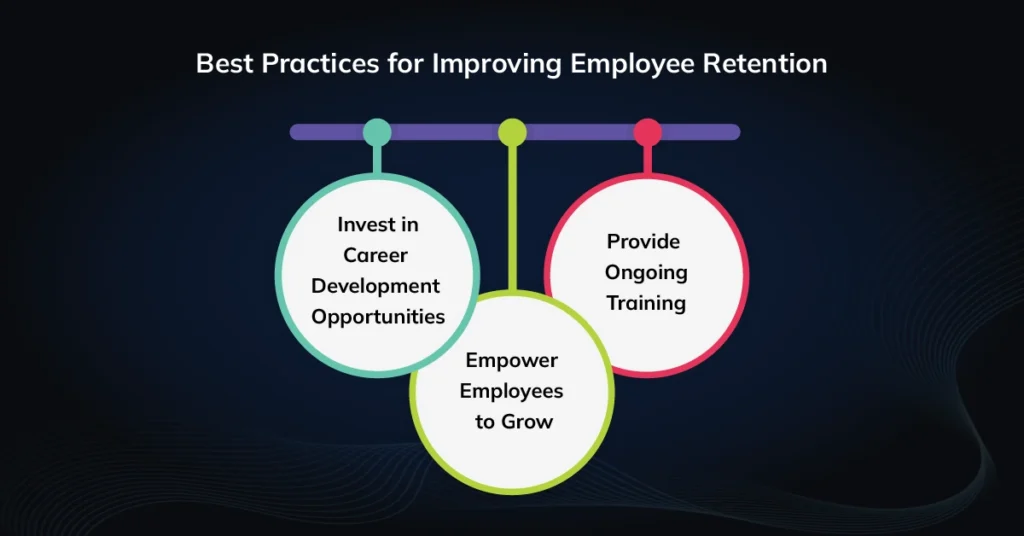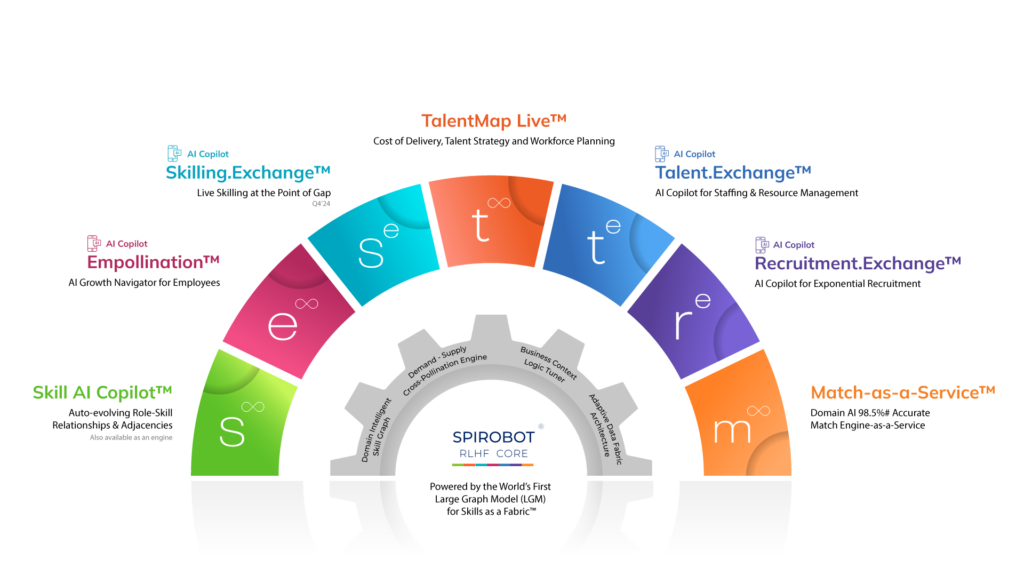In today’s competitive talent market, where skilled workers are in high demand, improving employee retention is a top priority for businesses of all sizes. High turnover rates can be incredibly costly, impacting productivity, morale, and the bottom line. But how can companies entice employees to stay and grow within the organization? The answer lies in creating a culture of employee development.
What are Best Practices for Improving Employee Retention?
Best practices for improving employee retention go beyond simply offering competitive salaries and benefits. It’s about creating an environment where employees feel valued and challenged and have opportunities to learn and advance their careers.
Here are some key strategies:
1. Invest in Career Development Opportunities
Employees crave a sense of purpose and growth. Offering clear career paths demonstrates a company’s commitment to its workforce. This can involve:
- Mentorship programs: Pair experienced employees with less experienced ones to provide guidance, support, and knowledge transfer.
- Internal training initiatives: Offer programs to help employees develop new skills and advance their careers.
- Tuition reimbursement: Help employees pay for relevant education or certifications to further their professional development.
- Job shadowing: Allow employees to observe colleagues in different roles to gain exposure to new opportunities and career paths.
- Internal mobility programs: Encourage employees to move between departments or organizational roles to broaden their experience and skill set.
2. Provide Ongoing Training
The skills needed for success are constantly evolving. Businesses prioritizing ongoing training provide employees with the tools to stay relevant and competitive. This can include:
- Technical training: Keep employees up-to-date on the latest industry trends and technologies.
- Soft skills training: Help employees develop essential skills like communication, leadership, and problem-solving.
- Professional development workshops: Offer workshops and seminars on time management, stress management, and work-life balance.
- Online learning platforms: Provide access to online resources and courses to facilitate continuous learning.
- Coaching and mentoring: Offer one-on-one coaching and mentoring sessions to help employees identify their strengths and weaknesses and set goals for their development.
3. Empower Employees to Grow
Don’t micromanage your employees! Encourage autonomy and provide opportunities for them to take on new challenges and responsibilities. This fosters a sense of ownership and engagement, leading to increased job satisfaction and retention. Consider these strategies:
- Delegation: Give employees the authority to make decisions and take ownership of their work.
- Project-based work: Assign employees to challenging projects that allow them to use their skills and develop new ones.
- Employee resource groups (ERGs): Support ERGs, allowing employees to connect with colleagues with similar backgrounds or interests.
- Flexible work arrangements: Offer flexible work arrangements, such as remote work or compressed workweeks, to improve work-life balance and job satisfaction.
- Feedback and recognition: Provide regular feedback and recognition to employees to acknowledge their contributions and motivate them to continue growing.
By implementing these best practices for improving employee retention, companies can create a talent-centric environment that attracts, motivates, and retains top performers.
The Impact of Employee Development on Retention
Studies consistently show a strong correlation between employee development and retention. Employees who feel their skills are valued and given opportunities to grow are more likely to be satisfied with their jobs and less likely to leave for other opportunities.
Key Benefits of Investing in Employee Development:
– Purpose and Meaning
– Challenge and Growth
– Recognition and Appreciation
– Enhanced Skills
– Increased Innovation
– Higher Quality Work
– Attracting Top Talent
– Positive Employer Reviews
– Customer Satisfaction
– Lower Turnover Rates
– Reduced Replacement Costs
– Increased Retention of Top Talent
Here are some of the key benefits of investing in employee development:
1. Increased Job Satisfaction and Engagement
- Purpose and Meaning: Employees who feel they are contributing to the company’s goals and developing their skills are likelier to be engaged and satisfied with their work.
- Challenge and Growth: Opportunities for learning and growth can help employees feel challenged and fulfilled.
- Recognition and Appreciation: Companies that invest in employee development send a clear message that they value their employees’ contributions and are committed to their long-term success.
2. Improved Performance and Productivity
- Enhanced Skills: Employees who receive ongoing training and development are better equipped to perform their jobs effectively and efficiently.
- Increased Innovation: A culture of learning and development can foster a more innovative and creative workforce.
- Higher Quality Work: Employees confident in their abilities are more likely to produce high-quality work.
3. Stronger Employer Brand and Reputation
- Attracting Top Talent: Companies that invest in employee development are more attractive to top talent.
- Positive Employer Reviews: Satisfied employees are more likely to recommend their company to others, leading to a positive employer brand reputation.
- Customer Satisfaction: Engaged and satisfied employees are likelier to provide excellent customer service, leading to higher customer satisfaction and loyalty.
4. Reduced Turnover and Costs
- Lower Turnover Rates: Employees who feel valued and have growth opportunities are less likely to leave for other jobs.
- Reduced Replacement Costs: High turnover can be costly for businesses due to the time and resources required to recruit and train new employees.
- Increased Retention of Top Talent: Companies can retain their most valuable employees by investing in employee development.
Spire.AI: Your AI Copilot for Implementing Best Practices for Improving Employee Retention
Employee development is an ongoing process, and keeping track of employee skills, aspirations, and growth opportunities can be challenging. This is where Spire.AI comes in. Spire.AI is an AI Copilot for Talent that helps organizations implement best practices for improving employee retention by leveraging AI-powered technology.
Spire.AI offers a comprehensive suite of solutions to support talent management in a Skills-Based Organization (SBO). Here’s how Spire.AI facilitates the implementation of best practices for improving employee retention:
- Auto-Evolving Role-Skill Framework: Spire.AI automates the creation and maintenance of a skills framework, ensuring everyone in the organization is on the same page. This framework maps skills to roles, making it easier for employees to identify development opportunities.
- Automatic AI-generated Employee Skill Profiles: Spire.AI gathers data from various sources to create accurate and up-to-date employee skill profiles. This helps to identify skill gaps and personalize development plans.
- Career Path Simulation and Reskilling Recommendations: Spire.AI uses AI to recommend specific learning and development opportunities based on an employee’s skills and career aspirations. This empowers employees to take ownership of their professional growth.
- Talent Marketplace: Spire.AI facilitates internal mobility by creating a platform for employees to explore opportunities across the organization. This helps employees find new challenges and advance their careers without leaving the company.
By leveraging Spire.AI’s AI-powered solutions, companies can proactively improve employee retention through effective employee development. Spire.AI empowers organizations to create a talent-centric environment that attracts, motivates, and retains top talent.
Conclusion
In today’s competitive landscape, best practices for improving employee retention are essential for business success. By investing in employee development, companies can create a thriving talent pool, reduce turnover costs, and build a more engaged and productive workforce.







